Anime pencil art is a wild ride—imagine sketching your own original character, then throwing them into a mashup battle with a ninja, a magical girl, or even a cat-eared hero. Mix up chibi doodles, dramatic shading, or wild outfit designs, and don’t forget those action-packed motion scenes! Fans can even blend animal traits with favorite characters for hilarious hybrids. Grab a pencil, grab some inspiration, and get ready—there are even cooler ideas coming up next.
Key Takeaways
- Create original characters with unique personalities, outfits, and distinct facial features to showcase your individual style.
- Reimagine classic anime characters in new art styles or chibi versions for a fresh creative challenge.
- Illustrate dynamic battle scenes using bold pencil strokes, motion lines, and dramatic shading techniques.
- Experiment with hybrid characters by incorporating animal traits like ears, tails, and textures for imaginative designs.
- Use a variety of pencils, blending stumps, and reference images to enhance depth, accuracy, and detail in your artwork.
Draw Your Own Anime Original Character (OC)
How do artists make a character that’s totally their own and not just a copy of someone else’s anime hero? It all starts with awesome drawing ideas!
First, they think about who their character is—like, what drives them, their quirks, or where they come from. Once the personality’s clear, they grab a pencil and sketch unique facial shapes, bold hairstyles, and killer outfits that match the character’s story.
If they want passion or mood, they tweak facial expressions and poses until everything just fits. A quick backstory adds even more depth, almost like giving their OC a soul.
Sure, artists might swipe a little inspiration from their favorite anime, but every detail keeps the character original, surprising, and totally theirs.
Create a Dynamic Anime Crossover Scene
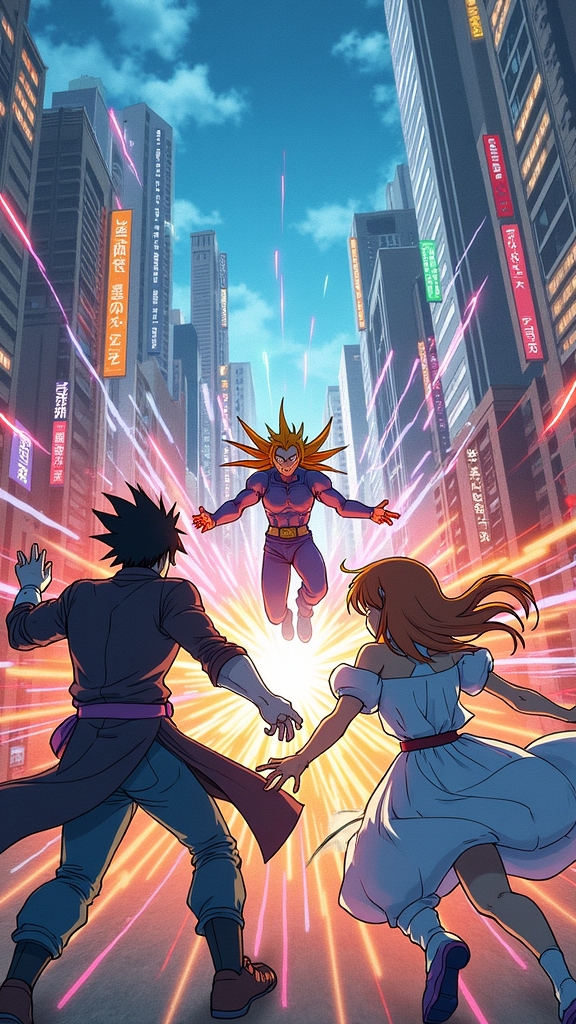
Mashing up characters from totally different anime worlds is like throwing the ultimate fan party on paper. Anime art gets super exciting when you pick heroes and villains from separate series and drop them into the same wild scene.
Imagine a ninja from Naruto chowing down with a titan from Attack on Titan in a neon-lit cyber café—totally epic, right? To make your crossover pop, choose characters whose personalities mix in fun or dramatic ways.
Picture a Naruto ninja sharing ramen with an Attack on Titan giant in a neon cyber café—that’s crossover anime at its craziest!
Throw them into a setting they’d never expect, toss in legendary props from both universes, and watch the story unfold. Use different art styles or color schemes to really make their differences stand out.
And don’t forget expressive poses—drama, shock, or even a slice of awkward friendship always brings crossover anime art alive!
Design a Unique Anime-Inspired Outfit
Even though everyone loves the classic anime outfits—think flowing capes, wild boots, or those hats that seriously defy gravity—it’s way more fun to design something totally unique.
When anime enthusiasts decide to design a unique anime-inspired outfit, it kicks off with picking a favorite character and scoping out what makes their style stand out. Is it the color scheme? The wild patterns? Or maybe some epic accessory no one else has?
After breaking it all down, adding futuristic touches or bold cultural elements can level up the look, making it feel new but still true to the character.
Trying out different fabrics on paper—like silky cloaks or rugged armor—can boost creativity. Don’t forget personal symbols or custom accessories to make the design pop!
Sketch a Chibi Version of a Favorite Character
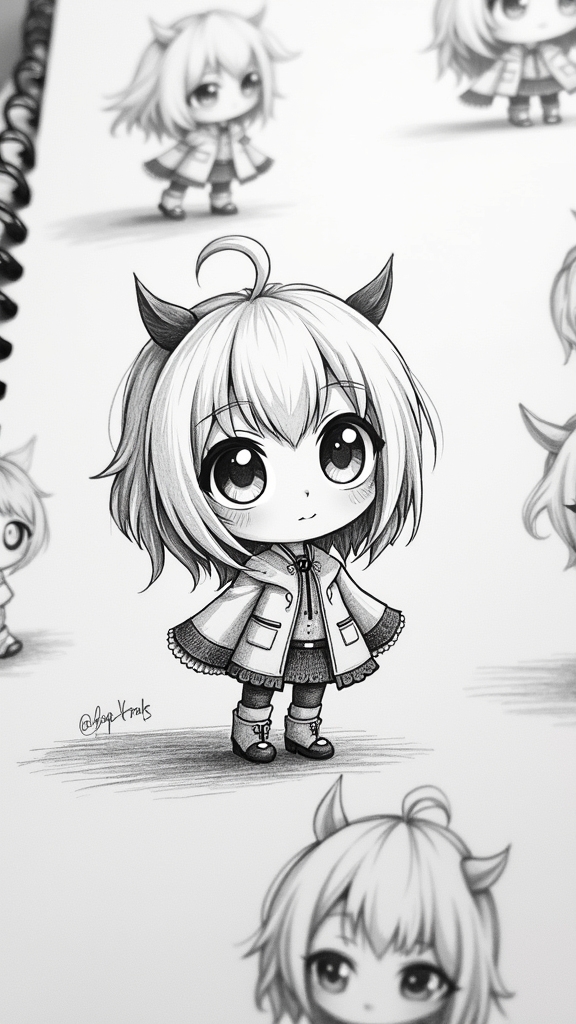
Making a chibi version of a favorite character is all about turning their most recognizable features into oversized, squishy-cute magic—think giant eyes, tiny hands, and that unforgettable hairstyle.
It helps to pick out their coolest accessories or quirks (maybe a little cape, or a favorite snack) and add them in for extra personality.
Simplify Distinctive Character Features
When someone decides to sketch a chibi version of their favorite anime character, things are about to get both adorable and hilarious. It’s all about simplifying those standout traits, like iconic hairstyles, signature outfits, or legendary scowls.
Think of Goku Ultra Instinct Drawing—his wild silver hair? That needs to stay, but way bigger! Start by outlining the pose with super simple shapes, then make the face the main event.
Chibi characters thrive on massive eyes and tiny mouths, showing off funny or cute expressions. Color brings the chibi to life, but don’t pile on details. Just stick with the essentials: unique color combos, and maybe a tiny accessory from the original design.
Even the simplest backgrounds can add personality without making things look too crowded.
Emphasize Exaggerated Proportions
Proportions go wild in the world of chibi art, and that’s exactly what makes these little drawings so ridiculously cute. When drawing a chibi version of favorite characters like Itachi Uchiha, Goku Ultra Instinct, or even Light Yagami (with or without mask!), start with huge heads and tiny bodies.
This exaggerated proportions style lets anime fans try fresh ideas and show their love for any anime series. Step by step, sketch basic shapes—circle for the head, little ovals for the body and limbs. Add signature details, like Goku’s spiky hair or a One Piece bandana, then grab your color pencil or acrylic markers for bold, easy anime coloring.
Practice UI Drawing and Ultra Instinct Drawing Step methods to enhance your skills, while remembering to read our Privacy and agree to Pinterest’s Terms of Service!
Add Playful Accessories
Once that big-headed, tiny-bodied chibi form is sketched out, the real fun begins—accessorizing! This is where artists get creative, adding hats, scarves, and silly props that make the chibi version of a favorite character truly stand out.
Want that ninja with a giant ramen bowl? Or maybe a magical girl holding a sparkly donut wand? Go for it! Playful accessories not only reflect the character’s personality, but also make the drawing more charming and unique.
Try using vibrant colors to notice how those details pop. Dynamic poses—like a chibi leaping in the air or shyly hiding behind a plush—bring these accessories to life.
Don’t forget a fun background or some cute patterns to finish off the overall playful chibi art style!
Illustrate an Epic Anime Battle Moment
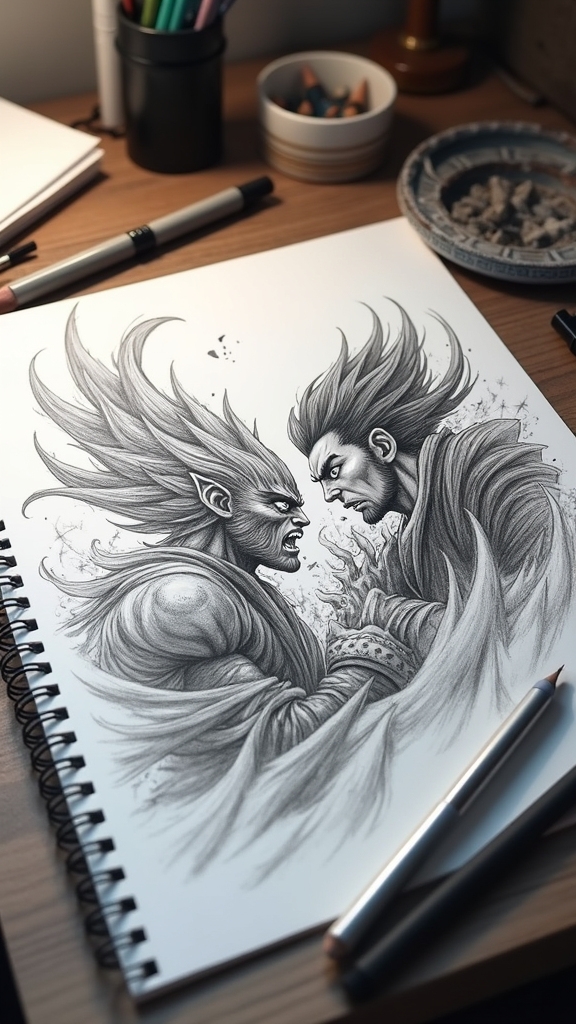
When drawing an epic anime battle moment, the action feels real when you choose bold, dynamic poses that make it look like the characters might leap off the page—seriously, it’s like “watch out, here comes a flying punch!”
Adding fierce facial expressions, wild hair, and tense muscles helps to show just how intense and emotional the fight really is.
Throw in some angled lines and dramatic backgrounds, and suddenly, your pencil battle is packed with excitement and energy.
Dynamic Poses and Expressions
A ton of epic anime battles start with totally wild poses and intense facial expressions, right? That’s because it’s all about energy—dynamic poses make each movement jump off the page! Artists love using sharp angles and exaggerated limbs, cranking up the action. Don’t forget about facial drama, either. Drawing eyes wide with rage, gritted teeth, or shocked gasps is perfect for showing how much each hit matters. And let’s not ignore Character Interactions—getting two rivals locked in a fierce stare or dramatic clash? Instant drama. Throw in some jagged shadows to highlight muscles and motion, then background chaos like flying debris or energy blasts for that “whoa!” factor. Here’s a handy table of ideas:
| Pose/Expression | Purpose |
|---|---|
| Angled Leaps Forward | Shows aggressive movement |
| Clenched Fists & Gritted Teeth | Displays determination |
| Eye Contact Between Rivals | Highlights Character Interactions |
| Shocked Faces With Wide Eyes | Amplifies surprise moments |
| Background Debris/Energy Blasts | Adds intensity and chaos |
Capturing Intense Action
Envision this: two heroes locked in a wild, all-out anime battle, fists flying and energy blasts lighting up the page like a fireworks show.
Capturing intense action in anime pencil art is all about movement and drama. Artists use bold Action Techniques—dynamic poses, exaggerated faces, and crazy foreshortening—to make things pop off the page.
Motion lines and bursts of energy really ramp up the wow-factor. Don’t forget powerful shading: shadows and bright flashes highlight the showdown.
Studying martial arts moves or epic fight scenes helps you nail the anatomy and movement. And, hey, a smashing background with shattered ground or flying debris amps up the chaos.
- Use foreshortening for wild, 3D effects
- Draw epic motion and energy lines
- Go bold with shading and contrast
- Look up real fight scene references
- Add explosive backgrounds for full drama
Draw a Classic Character in a New Art Style
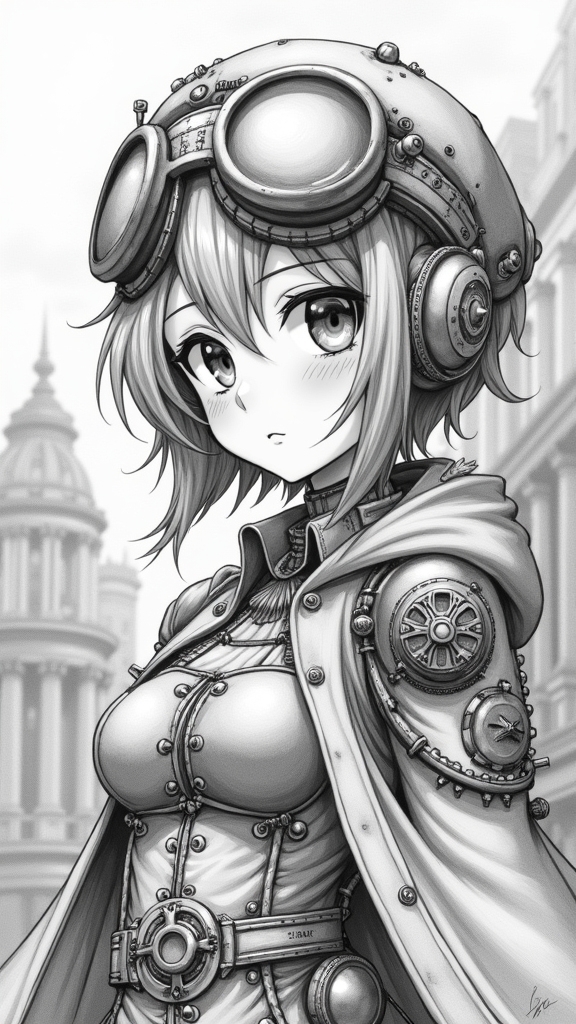
Although it might sound wild at first, transforming a classic anime character with a totally new art style is like giving your favorite hero a secret identity.
Imagine Pikachu drawn as a tough, brooding detective, or Goku reimagined as a chibi with huge eyes and tiny fists. Character Evolution is the heart of this process—pick a character you love, gather a few reference images, and study what makes them iconic.
Reimagine your favorite anime heroes—think Pikachu as a gritty detective or Goku as an adorable chibi with exaggerated features.
Then, try out different art styles, like realism, abstract, or even super-simplified designs. Sketch your character’s recognizable features first, then start exaggerating or shrinking what stands out.
Play around with fun shading tricks or oddball color schemes! This mashup can surprise you, revealing sides to characters that nobody’s ever seen before.
Reimagine an Iconic Scene With Pencil Textures
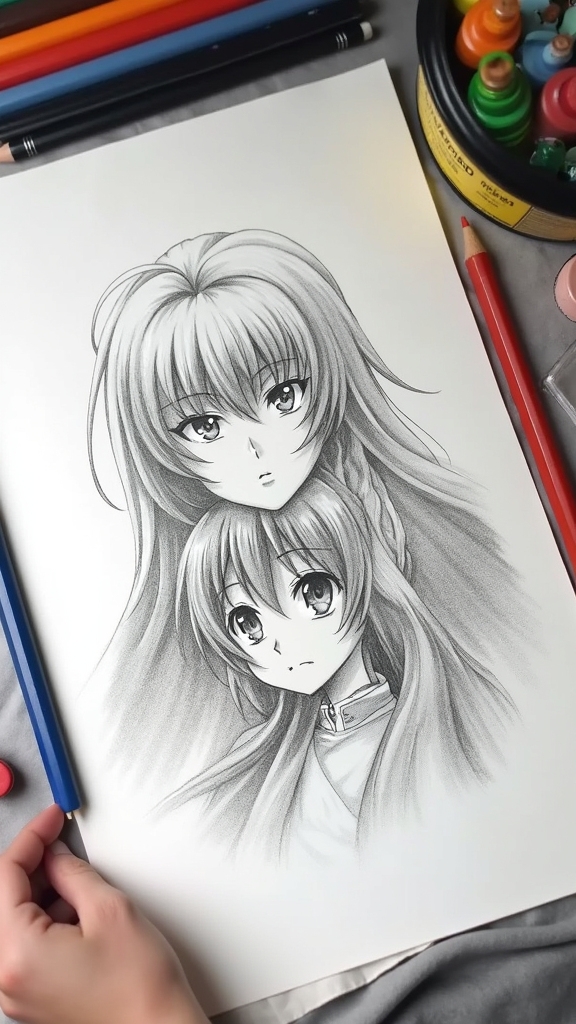
Reimagining an iconic anime scene with pencil textures is a chance to crank up the drama, using smart shading to make everything pop with depth.
Motion lines made with sharp or heavy pencil strokes can make a fight or chase almost leap off the page, while the right shadows around a character’s eyes or smile can show if they’re brave, heartbroken, or plotting something sneaky.
With each pencil mark, the scene gets fresh energy, making it feel real and emotional all over again.
Enhancing Depth With Shading
When an artist grabs a pencil and starts adding shadow to a drawing, something magical happens—the flat page starts to come alive, packed with energy and drama.
Using the right shading techniques, like hatching or cross-hatching, can make your favorite anime scene jump right off the sketchbook. But there’s more: knowing how to spot your light source helps you figure out where the darkest shadows and brightest highlights belong, making everything look three-dimensional.
Want to make things look smoother or extra moody? Blending tools are your new best friends. Plus, trying out different pencil grades can completely change the vibe of a scene.
- Try hatching for sharp shadows
- Play with cross-hatching for textured depth
- Use soft pencils for velvety darks
- Blend with tortillons for silky changes
- Sketch from anime reference images
Capturing Dynamic Motion Lines
After mastering how shadows give drawings that wow factor, there’s something else that makes anime art leap off the page—those electrifying motion lines! These swooshes and streaks aren’t just for show; they’re the magic behind fast punches, epic dodges, or flying hair. Using motion techniques like changing line thickness and direction, artists can crank up the energy of a scene. Even cooler, mixing in pencil textures—think cross-hatching or different shades—gives those motion lines extra oomph. To spark your creativity, here’s a quick table breaking down some common ways to capture action:
| Motion Line Style | Motion Techniques |
|---|---|
| Thick, long strokes | Super fast movement |
| Thin, short dashes | Slow or gentle actions |
| Cross-hatched edges | Added depth and texture |
| Directional lines | Follows action flow |
Emphasizing Character Emotions
Although most anime scenes are known for their wild battles or big dramatic reveals, the real magic sometimes happens in those quiet, close-up moments where a character’s feelings are right there on their face.
Pencil art lets artists zoom in on those scenes, using textures and shading to spotlight every bit of emotion. Emotion Analysis is key: subtle changes in eyebrows or a slightly trembling lip can tell a whole story. Smooth pencil strokes can make skin look soft while rough lines make hair seem frazzled, just like a character in distress.
Dramatic lighting—think deep shadows and sharp highlights—ramps up the tension even more. When artists reimagine iconic scenes, focusing on emotion, viewers get drawn right into the character’s world.
- Try out different pencil textures for unique expressions
- Use lighting contrasts to highlight strong emotions
- Focus on faces—seriously, the eyes say a lot!
- Use cross-hatching or stippling for dramatic effects
- Pick a famous scene and give it a bold new twist
Explore Expressive Anime Character Portraits
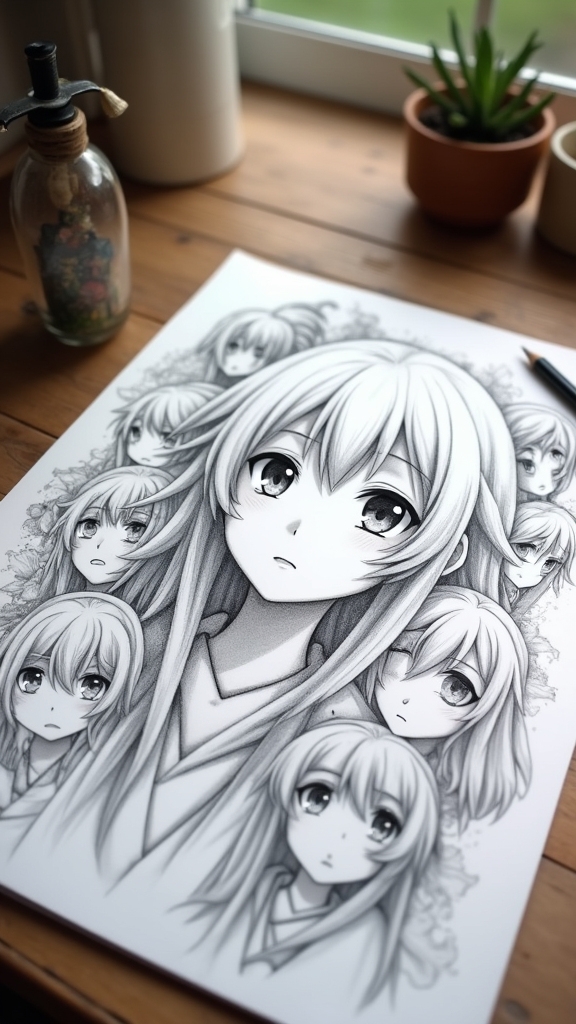
Ever wonder what makes anime character portraits pop right off the page? It’s all about those wild Facial Expressions!
Artists go all-out with big, shiny eyes, goofy or spiky hairstyles, and bold eyebrows to show emotion—sometimes you can almost hear a character shout, “Nani?!” through their face alone.
Adding dynamic poses, like someone mid-leap or with arms crossed in rage, cranks up the personality even more. Shading with colored pencils brings in cool effects, making features stand out or faces glow.
Want your portraits to look more real? Grab some reference images of real people or other artwork to study proportions.
Don’t be afraid to try different styles, like chibi or semi-realistic—variety keeps things fun and fresh!
Practice Dramatic Light and Shadow in Anime Art
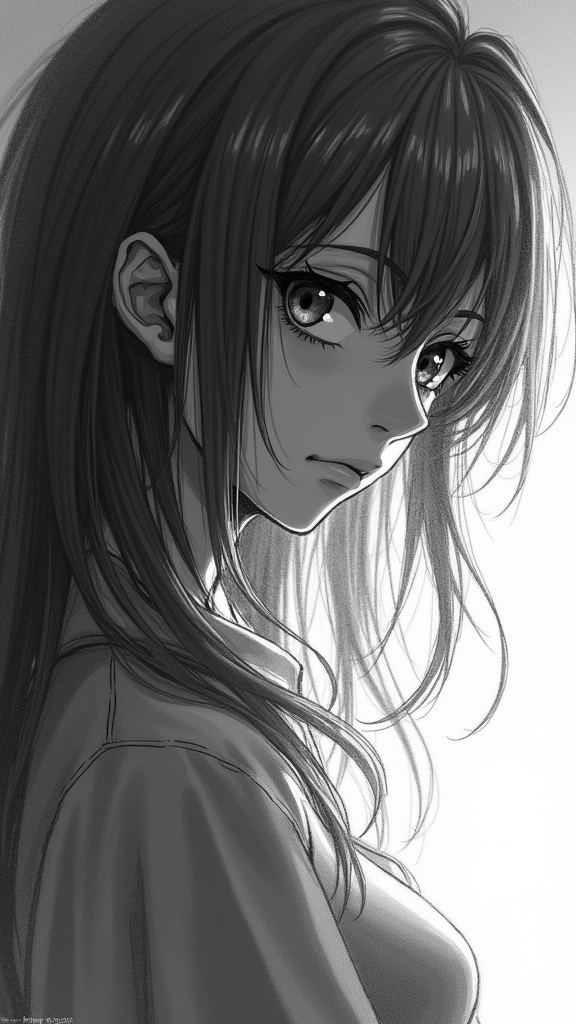
Turn up the drama—anime pencil art isn’t just about wild hair and big eyes; it’s also about playing with light and shadow to make scenes totally pop.
Light Exploration is a game-changer, helping artists crank up the intensity and realism of their drawings. Want to make your characters look like they’re straight out of an epic anime showdown or a mysterious alleyway scene? You’ll need to understand where the light’s coming from, how shadows fall, and how different shades bring moments to life.
Mastering light and shadow transforms your anime art from flat sketches to vivid scenes bursting with energy and atmosphere.
Don’t let your art stay flat—add dimension and vibes by experimenting with bold highlights and deep shadows.
- Observe real objects to see how shadows work in life
- Use hatching and cross-hatching for awesome shading
- Mix traditional and digital tools for cool effects
- Pump up the contrast for more drama
- Test different light angles for extra mood
Capture Motion With Action-Packed Poses
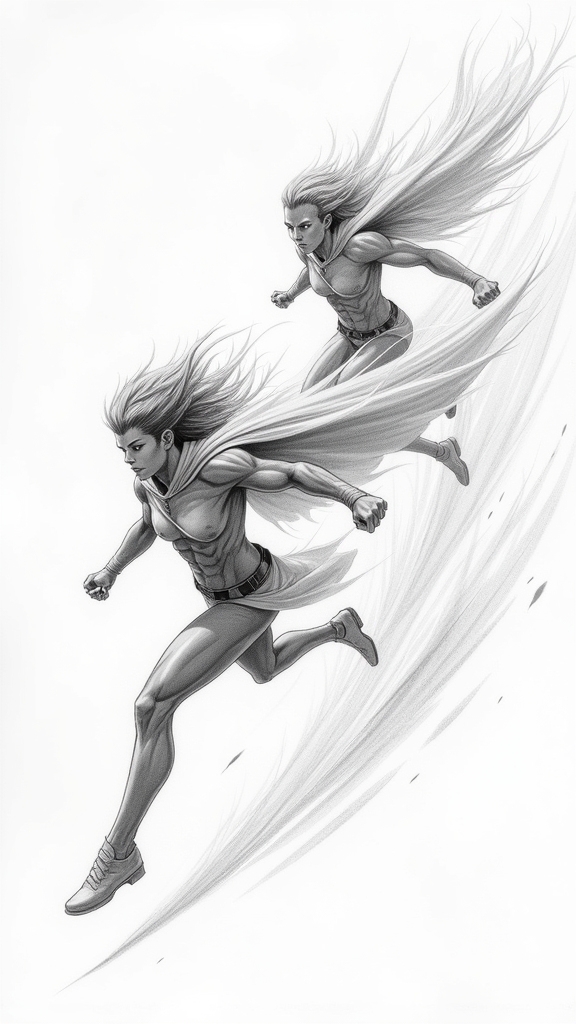
Once the shadows and highlights are rocking, there’s something even cooler to tackle—motion! Capturing motion with action-packed poses takes regular anime pencil art and turns it into a wild ride. Motion Techniques like foreshortening and overlapping lines make characters look like they’re leaping right out of the sketchbook. Studying dynamic poses from reference images, especially those crazy action scenes, is super helpful. Changing the perspective—like drawing from above or below—cranks up the excitement. Motion lines or speed effects? Total game changers for making your scenes burst with energy. Got a pencil? Try gesture drawings to quickly catch that movement vibe. Check the table below for ways you can use Motion Techniques in your next epic drawing:
| Pose Reference | Perspective Trick | Motion Lines Use |
|---|---|---|
| Jumping kick | Low angle | Around punching arm |
| Spinning attack | Bird’s eye view | By the spinning leg |
| Dodging dash | High angle | Trail behind foot |
Combine Animal Features With Human Characters
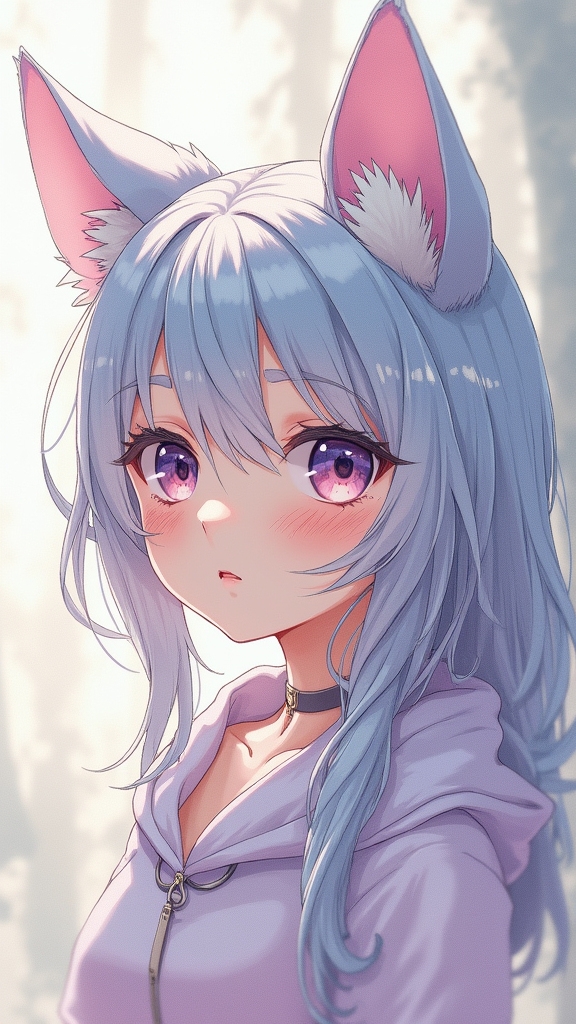
Although it might sound wild at first, mixing animal features with human characters—otherwise known as anthropomorphism—is basically a golden ticket to release creativity in anime pencil art.
Hybrid Characters take everything fun about animals and humans and smash them together for amazing new possibilities. Picture a cat-girl leaping rooftop to rooftop, or a wolf-boy with a moody glare and fuzzy ears.
It’s not just about cool looks—choosing animal traits lets artists add unique personality spikes and even hint at backstories. Just think: you can mess with proportions, draw nifty tails or claws, and use fur-inspired color shading.
Feeling stuck? Here’s a list to give your imagination a kickstart:
- Animal ears and expressive tails
- Clawed hands or feet
- Whiskers or fangs for attitude
- Animal-like agility in poses
- Wild, fur-textured hair
Hybrid Characters: endless epic!
Draw Popular Anime Characters Using Only Pencil
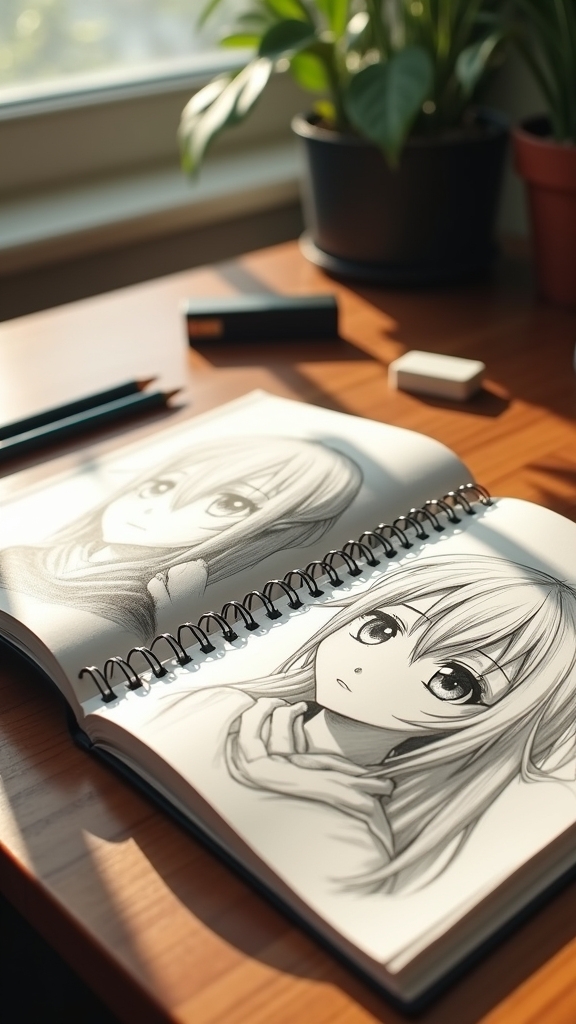
Grab a sketchbook and a trusty pencil—drawing favorite anime characters by hand is pretty much the ultimate badge of honor for any anime fan. When artists use only pencil, they get to focus on awesome shading techniques that give characters real depth and cool shadows. Pencil art can show off every detail, from wild hair spikes to intense Character Expressions and even the folds in a hero’s cloak. By playing with different pencils—think super hard, medium, and really soft—artists can nail the darkest darks and the softest highlights. Plus, sketching by hand is perfect for learning all about proportion and anatomy. Check out this table for some quick tips:
| Technique | Purpose | Example Character |
|---|---|---|
| Cross-hatching | Depth & texture | Naruto Uzumaki |
| Smudging | Soft shadows | Sailor Moon |
| Line weight | Emotion & action | Deku (My Hero Academia) |
Frequently Asked Questions
What Pencil Do Anime Artists Use?
Anime artists commonly use mechanical pencils for precision, along with HB, 2B, and 4B graphite pencils to achieve various pencil techniques. Colored pencils, including Prismacolor, and pastel or watercolor pencils, further broaden their artistic approaches.
Can I Draw Anime With No Experience?
The Current Question explores if one can draw anime with no experience. Utilizing Beginner Techniques, such as practicing basic shapes and studying online tutorials, enables newcomers to develop foundational skills and gradually improve their anime art abilities over time.
Can Drawing Anime Be a Job?
Drawing anime can indeed become an Anime Career, as the animation industry offers roles for artists in character design, illustration, and more. Social media, freelance platforms, and digital content creation have expanded pathways for professional success.
What Do Anime Artists Draw With?
Anime artists often utilize a diverse range of art supplies, including color pencils, mechanical pencils, ink pens, and digital tools. Traditional media like markers and watercolors are also commonly employed to create detailed, vibrant, and visually appealing works.
Conclusion
Anime pencil art isn’t just cool—it’s seriously fun and totally doable for anyone who loves to draw, whether you’re a beginner doodler or leveling up your sketchbook game. With these ideas, fans and artists can bring wild battles, cute chibi friends, and amazing outfits to life using only a pencil! So, grab your sketchbook, sharpen that pencil, and let your imagination go a little wild. Who knows? Your next masterpiece might already be racing around in your mind!

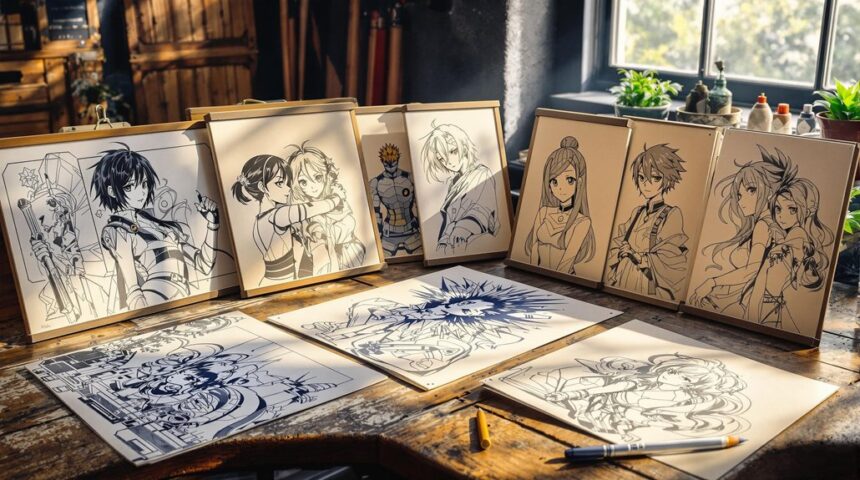
Leave a Reply